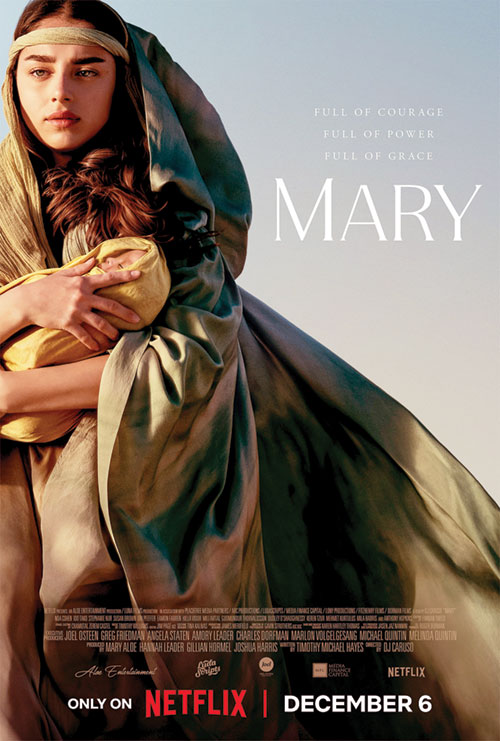Netflix’s movie Mary is worthwhile viewing—with some caveats

(Image courtesy of Netflix)
By Ann Margaret Lewis
As Christmas nears, new holiday-related films pop up on streaming services. Most are secular adventures surrounding the mythos of Santa Claus. A few religious offerings will surface as well, purporting to give a fresh take on the Nativity narrative.
The latter is the case with Mary, a Netflix film directed by Catholic film director DJ Caruso and produced, in part, by television evangelist Joel Osteen among others, which tells the story of Mary’s life as the chosen mother of the Redeemer.
The film is dedicated to the late Los Angeles Auxiliary Bishop David G. O’Connell, who was murdered in his home in 2023. And yet the film is not necessarily made with a Catholic point of view. It is, for the most part, an adventure film that pulls elements from non-scriptural sources from the early Church that serve as a basis for many traditional Catholic beliefs about Mary and her early life. Those elements are used to tell the story of Mary’s birth to SS. Joachim and Anne and service as a youth in the Temple in Jerusalem. It then extracts from the Gospel narratives the story of her betrothal to Joseph, the annunciation and birth of Christ and the slaughter of the innocents in Bethlehem at Herod’s command.
What it adds to these sources is adventure—being persecuted for her questionable pregnancy and pursued by soldiers during Herod’s edict to murder the infant boys of Bethlehem.
The film has high production value. The settings and costumes are lush. The acting performances are well done, especially Sir Anthony Hopkins as Herod. Hopkins has a remarkable way of making language that most would find clunky become seamless, lending gravitas to his role as an aging, corrupt king. His story arc offsets and contrasts well with the journey of Mary, lovingly and effectively played by Noa Cohen (Silent Game, 2022).
While the film is well done, Catholic viewers should be aware that it’s not “immaculate,” and that some minor portions do not necessarily fit with Catholic teaching or tradition.
First, with Mary’s character. I’ve seen this often with Protestant presentations of Mary, including “The Chosen,” that she is doubtful or unsatisfied with her life as it is. For the most part, her role in this film is that of a virtuous young lady. However, she once proclaims her life as “dull,” and there is one point where she stretches the truth when questioned as to whether she was “dallying in the gardens again.” She was, and yet she implies she was not. Additionally, like in other nativity films, she gives birth in pain, pain that some might believe by pious tradition she did not experience.
Joseph, too, might give Catholic viewers pause when he states that he “can only believe what he sees with his own eyes.” I could have forgiven this line had he later experienced the dream that set him on the path of accepting Mary and his role as foster father to the Messiah. But, sadly, that was eliminated in this tale. Even so, he steps up to the role of protector, saving her from being stoned and taking her into his home out of love for her, which is admirable.
The relationship between Mary and Joseph is therefore seen as slightly more romantic between two young people. And yet, there is no physical demonstrations of it that might offend the Catholic viewer.
There were, however, a few throw-away lines that were eyerolling. One was from the prophetess Anna who tells Mary, “Trust the strength inside you.” This is typical Hollywood pablum, of course. Anna would have told Mary to trust in God. Also, an inn hostess implies that Bethlehem was crowded not necessarily because of the census, but that word of the Magi’s visit to Herod had reached the masses, and that people visited Bethlehem to witness it. One would think if that were the case, someone would have eagerly given a room to a young woman about to give birth. Certainly, having the Messiah born in your hotel would be a selling point.
Nevertheless, there are some insertions I did like, such as the appearance of Satan to tempt and taunt the Blessed Mother. Even Christ had to contend with temptation, as did many other saints. That she also would have faced temptation makes sense, and the performance of Eamon Farren (“The Witcher,” 2023) as Satan is creepily effective.
Overall, I think the film is worth watching, as long as one keeps in mind it is a fictional extrapolation of what might have occurred, and that it has imperfections from a Catholic perspective.
Mary becomes available on Netflix on Dec. 6. For more information, go to netflix.com/mary. †
